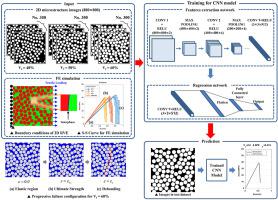Composites Part B: Engineering ( IF 12.7 ) Pub Date : 2021-09-14 , DOI: 10.1016/j.compositesb.2021.109314 Do-Won Kim 1 , Jae Hyuk Lim 1 , Seungchul Lee 2

|
In this work, we propose a prediction model of the transverse mechanical behavior of unidirectional (UD) composites containing complex microstructure with the help of a convolutional neural network (CNN). For this prediction, a total of 900 representative volume elements (RVE) samples were generated by constructing 300 RVEs for each of 40%, 50%, and 60% with the random sequential expansion (RSE) algorithm. The stress-strain (S–S) curves in terms of transverse elastic modulus, transverse tensile strength, and toughness considering interphase debonding were obtained by a finite element (FE) simulation with the RVE samples. After converting FE models with 900 RVE samples to corresponding microstructural binary images, CNN modeling was employed to construct a prediction model on the microstructural images. To demonstrate the performance of the proposed CNN model, we predicted the transverse mechanical behavior in terms of the S–S curves on various test datasets. Prediction accuracy was verified in terms of the loss functions and the error of the S–S curve. The prediction results were in excellent agreement with the test datasets, and the transverse mechanical behavior was quickly predicted for other microstructures. This confirmed that the proposed CNN model is simple and powerful and can efficiently clarify the relationship between the microstructure and transverse mechanical behavior of UD composites.
中文翻译:

通过卷积神经网络预测和验证考虑界面脱粘的单向复合材料的横向力学行为
在这项工作中,我们在卷积神经网络 (CNN) 的帮助下提出了一种包含复杂微观结构的单向 (UD) 复合材料的横向力学行为的预测模型。对于此预测,通过为每个样本构建 300 个 RVE,总共生成了 900 个代表性体积元素 (RVE) 样本。40%、50% 和 60% 的随机顺序扩展 (RSE) 算法。考虑相间剥离的横向弹性模量、横向拉伸强度和韧性方面的应力-应变 (S-S) 曲线是通过有限元 (FE) 模拟获得的 RVE 样品。将具有 900 个 RVE 样本的 FE 模型转换为相应的微观结构二值图像后,采用 CNN 建模对微观结构图像构建预测模型。为了证明所提出的 CNN 模型的性能,我们根据各种测试数据集上的 S-S 曲线预测了横向力学行为。根据损失函数和 S-S 曲线的误差验证了预测的准确性。预测结果与测试数据集非常吻合,并且可以快速预测其他微观结构的横向力学行为。这证实了所提出的 CNN 模型简单而强大,可以有效地阐明 UD 复合材料的微观结构与横向力学行为之间的关系。











































 京公网安备 11010802027423号
京公网安备 11010802027423号